Orchis, Satyrion
Testiculus; Dog StonesSalab Misri (Ayurveda)
Salep, Salab (Unani)
Dbang po lag pa དབང་པོ་ལག་པ (Tibetan)

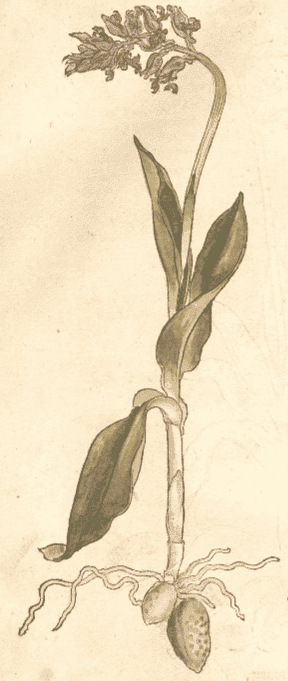 Male Satyrion
Male SatyrionHerbarum Vivae Eicones, Otto Brunfels, 1530 |
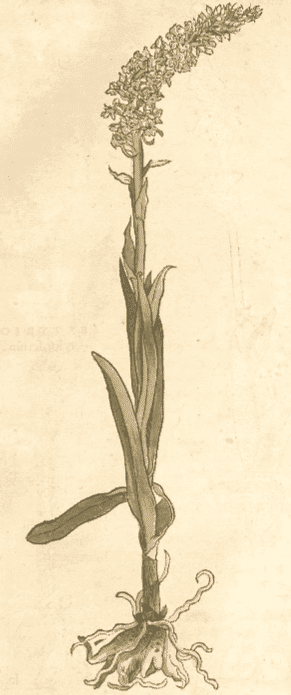 Female Satyrion
Female SatyrionHerbarum Vivae Eicones, Otto Brunfels, 1530 |
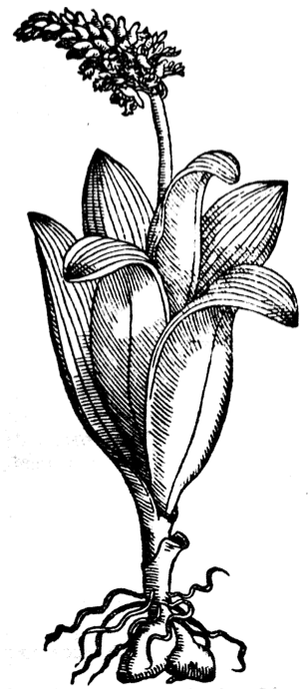
|
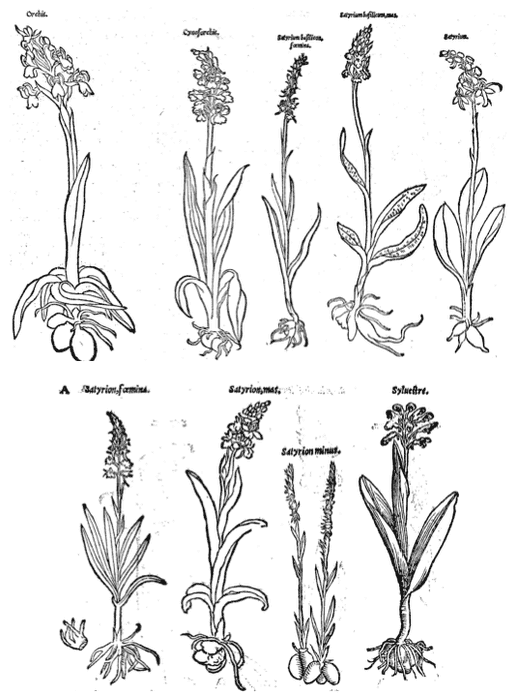
|
|
Della Materia Medicinale Andrea Valuassori, 1562 |
Several different species of Satyrion from Dioscorides Materia Medica, Ruellio, 1549 |
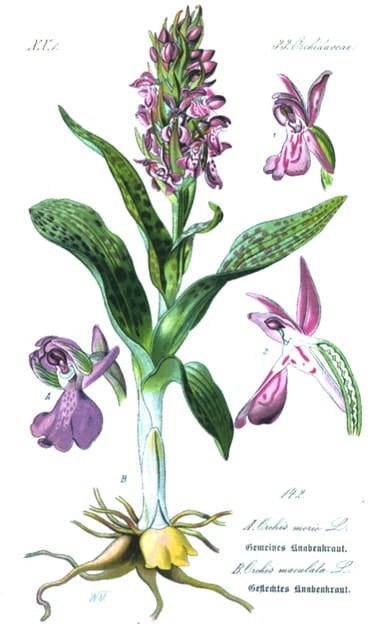 Orchis maculata
Orchis maculata(‘A’ being the flower of O. morio) Flora von Deutschland, Kohler, 1886 |
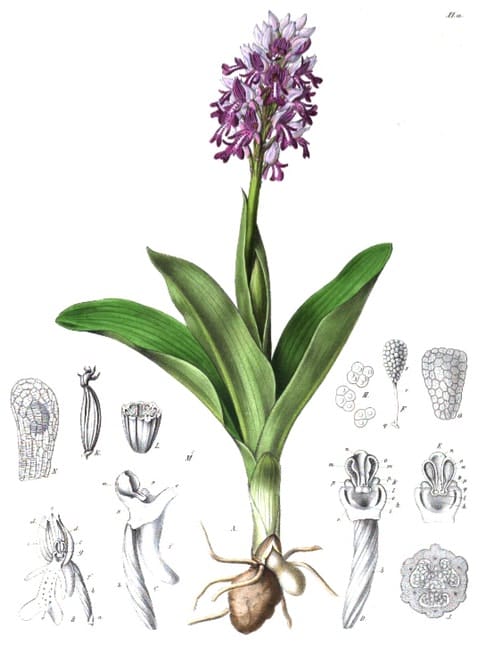 Orchis militaris
Orchis militarisDarstellung und Beschreibung Pharmacopoea Borussica, Berg, 1858 |
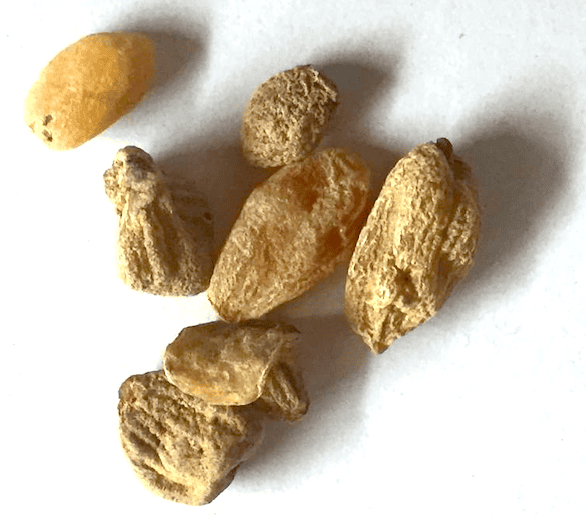
|
Left: Orchid ‘Salab‘ as used by the Muslim Uyghur minority in XinJiang, China (Photo, Adam 2017) |
 Members CLICK HERE for the PRO VERSION
Members CLICK HERE for the PRO VERSIONBotanical name:
Orchis maculata (Spotted Orchid), O. mascula (Purple Orchid) and others
‘There are diverse sorts of Satyrions, of which, though used promiscuously, the Shops choose the Dogs-stones, or Cynosorchim’. (Schroder)
Parts used:
Root (Tuber)
Temperature & Taste:
Warm, moist. Sweet.
Classifications:
3I. APHRODISIAC. 3J. INCREASE SEMEN
4i. UTERINE. 4j. NERVINE
Uses:
1. Strengthens Kidney Yin and Yang:
2. Benefits Womb:
3. Benefits the Spleen and Qi:
Dose:
Usually used in Pills, Powders and Electuaries.
POWDER: 500mg–3 grams
Substitute:
1. Many different species of Orchidaceae have supplied Satyrion
2. Dactylorhiza, Finger root

Main Combinations:
1. Salep: a restorative tonic that restores sexual function and promotes health … available in PRO version
2. Impotence and Infertility, Orchis with … available in PRO version
3. To increase Kidney Yang, for Impotence, to increase Sperm, Orchis with … available in PRO version
4. As an aphrodisiac and to increase Sperm, Orchis with … available in PRO version
5. For Spermatorrhea, Nocturnal Emission, Orchis with … available in PRO version
Electuary of Orchid (Diasatyrion) (Nicholas)
Antidote for Cold Kidneys and to Excite Libido (Nicholas)
Antidote for Cold Lumbar, for Venery, and Defect of Semen (Nicholas)
Triphala Electuary Greater (Unani)
Cautions:
Generally Safe
Main Preparations used:
Candied Root, Extracts, Essences and Diasatyrion were all used
-
Extra Info
-
History
|
‘Theophrastus (P. H. ix.,19), and Dioscorides (iii., 132, 133, 134, 135), mention several tuberous roots which were used by the Greeks under the names of Orchis or Serapias and Satyrion. It is not known exactly what all of these were, but it is certain that some of them were the tubers of different species of Orchis, [?] is described by the ancients as having a twofold root, formed of tuberosities which resemble the testes in appearance. The larger of these tuberosities, or, as some say, the harder of the two, taken in water, was thought to be provocative of lust; while the smaller, or, according to some, the softer one, taken in goat’s milk, was considered to be antaphrodisiac. The tubers were also used as a remedy for ulcerations of the mouth and pituitous discharges from the chest, and were taken in wine as an astringent. Mahometan physicians describe Orchis tubers under the name of Khusyu-uth-thalab (or salab), ” foxes’ testicles,” and state that the odour of them, when fresh, resembles that of semen hominis, and that they have an aphrodisiac effect if clasped in the hand. The dried tubers have a great reputation in the East as a nervine tonic and restorative, and are much prescribed in paralytic affections. It was formerly supposed that Oriental Salep was obtained from certain species of Eulophia, but the tubers of these plants have no resemblance to the commercial article, and Aitchison has now established the fact |
that the two plants placed at the head of this article yield the bulk of the Persian salep. Eulophia campestris, Wall., is, however, used locally in Northern India as a substitute for salep. In Southern India the tubers of several species of Habenaria and Orchis are collected by people in the hilly districts and sold locally as salep, but they are usually small and variable in appearance. Salep is now regarded in Europe as very nutritious; it tends to confine the bowels, and is, therefore, a useful article of diet for those who suffer from diarrhoea. The mucilage is prepared by first macerating powdered salep in cold water, and gradually adding boiling water, with stirring, in the proportion of 5grains of salep to the ounce. Instead of water, milk or some animal broth may be used. Salep jelly may be made as follows: Rub 60 grains of powdered salep with water in a mortar until it has swollen to four times its original bulk ; then add gradually, and with constant stirring, 16 ounces of boiling water, and boil down to 8 ounces, Ainslie states that salep has the property of depriving salt water of its salt taste.’ (Pharmacographia Indica, Dymock, 1893) |
